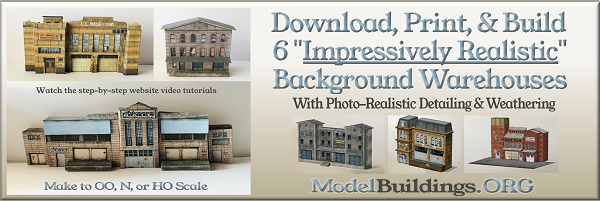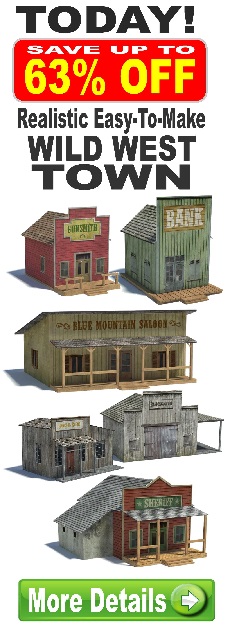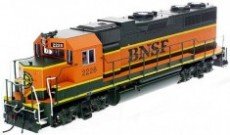Everything on model trains, model railroads, model railways, locomotives, model train layouts, scenery, wiring, DCC and more. Enjoy the world's best hobby... model railroading!
Lost Wiring Instructions
Murray asks readers:
“I accidentally cut the wires between the loco and tender on my Berkshire N scale 2-8-4 Bachmann Kanawha train. Where can I find the wiring instructions. They don’t seem to be listed on either Bachmann’s site or Sound Traxx’s site. The decoder is marked with symbols R, M+, L+, L-, M- and L. What do they stand for. I’m new at this and any help would be appreciated.”
What is the Minimum Radius for Trains?
Allan asks readers:
“Hi I am starting an HO layout on 4×8 or 5×9 board and want 2 levels but my problem is I want the track to climb 100mm (4 inch) in a complete circle. What I want to know is what is the minimum radius that I can climb to achieve this please? I am using strong engines and only about 5-6 wagons so won’t have much weight to pull up incline. Thanks for any help on this please.”
How To Replace Cogs Without Damaging Loco
Owen asks readers:
“Hi I have a loco (b12 4-6-0) that I need to replace a cog in and I can’t do that without taking off the rods that connect to the wheels and I don’t know how to take them off and put them back in without damaging it. Any help would be greatly appreciated.”
Fixing A Track Power Problem
Josh asks readers:
“I hope this doesn’t sound stupid but I can’t get power on my HO tracks. I laid the track, and it seemed to operate smoothly. Even after I wired up my points it was working ok. I tested everything again before laying the ballast. After the ballast dried I tested it again with my only loco (yes I’m new to railroading!!) and got no power to the track. I then tried taking away some of the ballast near the contacts, but I still couldn’t get it to run. I feel embarrassed asking for help because I’ve probably made a stupid mistake somewhere along the line, but I’m stuck and don’t know what to try from here. Please help.”
Interesting Way To Combine Rail Yard Structures For Increased Background Perspective
This new series of low relief railroad yard buildings includes 4 white buildings that jut out on an angle from the background, yet still only take up minimal space. The interesting thing is they can be arranged in a variety of positions to change the look of the complete structure… so the tallest building can be positioned on the end or in the middle. This short video shows how.
More details at http://www.modelbuildings.org/background-yard-structures.html
What’s Better Than Scenery Made With Paper and Plaster?
Ernie has a question for readers:
“I am getting ready to build scenery on my layout and thought of using wads of paper under the plaster cloth. However I’m not sure what to do now after reading somewhere that paper will suck in moister over time. Is this true? What could I use instead of paper?”
Problems Constructing A Helix
Sherri is planning a helix and has a question for readers relating to online helix calculators and uses the example of the free helix calculator at http://www.modelbuildings.org/free-calculator-tools.html to explain her problem:
“On the Helix Calculator “Item D” you can choose a ring width as small as 1″. This number is used to reflect how many sheets or fraction of sheets of plywood you will need as shown in “Item M”.
In “Item F” the formula adds 4″ to whatever radius size you choose in “Item A”. Therefore, I believe the minimum ring width would be 2″ plus one half the width of the gauge track you are using. At that calculation the inside edge of the track would be right at the inside edge of the ring. If you center the track in the ring, then I believe the minimum width of the ring would have to be 4″ instead of the minimum 1″ as shown in “Item D”. Am I correct, or am I missing something?”
Why Do DCC Bachmann Locomotives Run In Wrong Direction?
Duane asks readers:
“I have Bachmann 2 DCC steam locomotives of the same kind. One of them started moving in the wrong direction. I was using a magnet (which is under the track) that came with the Bachmann train system track to uncouple the rolling stock. While, I was in the process of doing so the train was backing up. Then, it goes in the forward direction on its own and stopped working. Did the decoder die? The warranty is no longer good can this be fixed? ”
How Do I Install A Sound Decoder?
Terry asks readers:
“I have an old Proto 2000 engine which must have owned for at least 15 years, and I want to install a sound decoder. I am a bit frightened where to start and if I’ll do any damage. Do I need to unhook little computer board behind the motor? I presume the old board was partly used to control the MARS signal-safety light. I do have resistors and LED’s. Will this decoder operate with the board in position, or will I have problems? Any advice on installation would be greatly appreciated. Thank you.”
How Many Lights Can Be Run Off A Transformer?
Reynold asks readers for advice:
“My N scale layout has 78 building yard lights not including the signals which I have spread over 4 transformers. If possible I would like to have them set up to all operate off just one power supply specifically for lighting. Is this hard to do? What would I need as a minimum transformer power output? I am hoping someone can shed some light on the problem – sorry about the bad pun!!!”
Using Tall Thin Backdrop Buildings To Save Space and Give The Illusion Your Rail Yard Stretches Full Depth
Rail yards are an important part of most model railroads not just because that look interesting, but also because they provide a lot of operational possibilities. Rail yards shouldn’t become a bottleneck that brings the railroad to a stand still. That can be very frustrating!
At the very least there should be enough track for the trains you’re operating and possibly another couple of tracks for train arrivals and departures. However, finding enough space to operate an efficient rail yard can be a problem, and that’s where background buildings can become a great space-saver.
Instead of using a full-sized 3D building which will potential take up valuable space that could otherwise be used for more track, it is possible to achieve the sane effect with thinner “low relief” 3 sided buildings or “flats” which are just frontages. The backdrop buildings need only be an inch or two deep to still give the illusion the building stretches full depth. That way you’ll have space for more yard track. This video shows some good examples of tall backdrop buildings.
How to make tall these tall backdrop buildings
Derailment On A Switch
Steven has an o-gauge, 3 rail layout and asks readers:
“I have a switch that I put it in a loop, so the engine can come back in a different direction. Problem is; once the switch is in main line straight and the engine goes through it, no problem, but when engine is coming around the loop, the engine approach it for a curve switch and the switch freezes on the straight line and it does not turn to a curve position for the engine to go in opposite direction, which causes a derailment. How can I fix this problem. I have limited space for this layout. Please help!!!!!!!!!! Thanks.”
Will 8 Amps Damage My Engines?
Club member Frank has a question for readers:
“I have been dabbling in the hobby for some time now but only in a small space. I thought I would expand my N scale track in another room and go DCC with eventually 8 to 10 engines – that’s my dream. A fellow at the train show said an 8 amp unit might damage my engines and I would be safer sticking to 5 amps. I thought that sounded kinda weird?? Is he right?”















